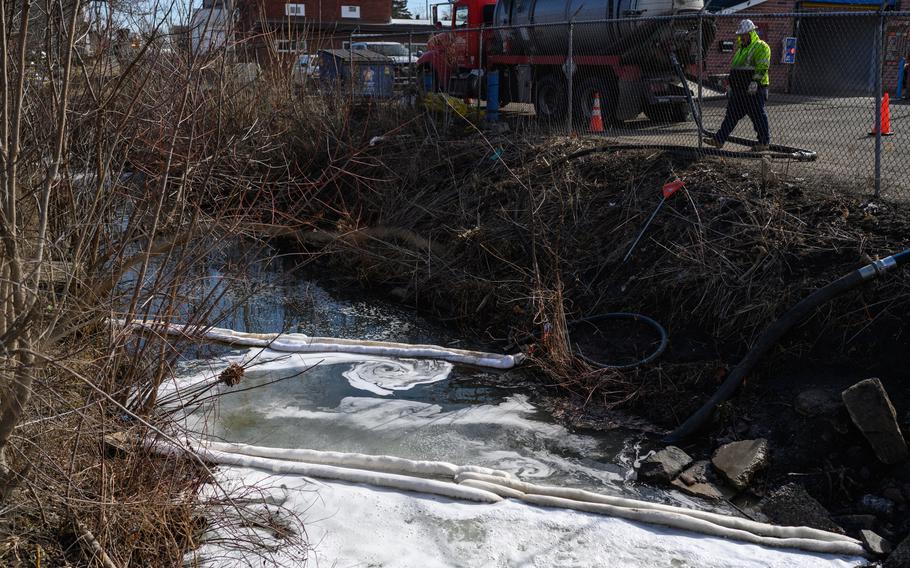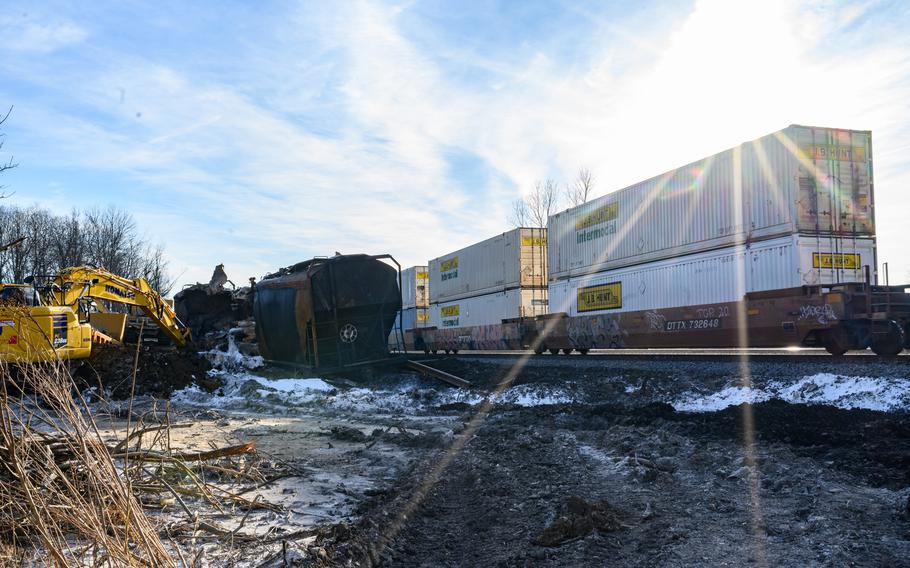U.S.
Ohio train derailment leaves ‘toxic soup’ of multiple chemicals
The Washington Post February 14, 2023

Crews work along a creek where chemicals from the derailment are present. (Rebecca Kiger/for The Washington Post)
EAST PALESTINE, Ohio — Officials told residents who live near the site where a train derailed and spilled toxic chemicals on Feb. 3 to drink bottled water until officials receive more test results of the municipal drinking water supply.
State environmental and health officials said the air quality remains safe
The train, which derailed along the Ohio-Pennsylvania border Feb. 3, was carrying a broader array of toxic chemicals than was first publicly detailed, the Environmental Protection Agency has disclosed, though the agency has said it is not detecting any hazardous levels of toxins in the area.
The disclosure has further elevated concern among residents of East Palestine, many of whom are still seeking answers about the amount of potential exposure to toxic fumes — immediately after the crash and now — and whether it is safe for evacuated residents to return to their homes. Even some who weren’t ordered to evacuate are wondering whether they should consider leaving the area.
“We should have been evacuated. It stunk for 48 hours,” said Jackie Moore, 34, of Darlington, Pa., roughly 8 miles away. From her home, the flames smelled like nail polish, she said.
The odor is still present in East Palestine, and it is unnerving residents. After more than a week of questions about what the train was carrying, the EPA on Sunday published a list from Norfolk Southern that confirmed which chemicals had spilled and showed which rail cars had been breached. There were 20 train cars carrying hazardous materials, 10 of which derailed, the National Transportation Safety Board reported Tuesday.
It is unclear whether chemicals continue to be released from the site of the derailment. In addition to still smelling odors, nearby residents have experienced headaches, burning eyes and other symptoms.
On Tuesday morning, this town in eastern Ohio was quiet except for the hum of industrial equipment. Up the hill, a sign at the Dairy Mill, an ice cream shop closed for the season, read “Please Pray for EP.”
At the site of the accident, cleanup workers were using cranes and other heavy machinery, hauling sheets of metal by hand, and moving wreckage into dumpsters Tuesday. They were wearing boots and hard hats, but none were masked or had other protective gear.
In one part of the site, white powder coated the ground. Meanwhile, trains continue coming through on the tracks.
Moore, whose family owns a local trucking company, stopped near the site Tuesday to take pictures of a pond. She has been documenting dead fish on her TikTok page.
Moore, her husband and their three children are drinking bottled water. “I don’t think anyone is drinking the [tap] water,” she said.

Scenes from train derailment in East Palestine, Ohio, on Feb. 14. (Rebecca Kiger/for The Washington Post)
A chemical ‘soup’
When the 150-car Norfolk Southern train derailed Feb. 3, federal investigators and chemical safety experts immediately homed in on a toxic and highly flammable gas being transported in five of the cars: vinyl chloride. Afraid the train cars would explode, sending shrapnel into neighborhoods, authorities decided to release and burn the vinyl chloride — a move that sent dangerous gases, hydrogen chloride and phosgene, into the air.
Questions swirled among residents about what else had leaked from the train. The EPA later said several more toxic chemicals were on board. They included ethylene glycol monobutyl ether, ethylhexyl acrylate, isobutylene and butyl acrylate.
The cars holding ethylhexyl acrylate and butyl acrylate were breached in the crash, and some amount of the chemicals was lost. Vinyl chloride and butyl acrylate were the primary chemicals that were released in the accident, Ohio EPA spokesman James Lee told The Washington Post on Tuesday.
Neither government agencies nor the railroad has detailed what quantity of the chemicals was released into the air or how much spilled on the ground. Whether the air is now safe to breathe largely depends on whether chemicals are still being emitted, experts have said.
“How much of it was there? How many gallons was it?” said environmental epidemiologist Lynn R. Goldman, dean of public health at George Washington University and a former EPA official.
Residents near the crash site have reported symptoms such as headache and nausea, which are consistent with what some of the chemicals can trigger.
“I wouldn’t want to be exposed to any of them in significant amounts,” Erik D. Olson, a senior strategic director at the Natural Resources Defense Council, an environmental advocacy group, said in an email. “They all pose hazards if inhaled.”
The EPA has said that no concerning levels of toxins have been detected in the air, though some experts cast doubt on the initial measurements, telling The Post the testing should have been more robust. The EPA said it provided data to health agencies before the decision was made to allow evacuated residents to come back last week.
After a fire or chemical release ends, the air eventually becomes clear, experts said, and the contamination concern shifts to what is on the ground or could have gotten into the soil.
But with residents in East Palestine still smelling odors, unease remains.
“What’s really important is that the government officials are monitoring the levels to make sure that they’re safe and clearly communicating that,” Goldman said. “But if you’re smelling these odors and they’re making you feel sick, I would want to be somewhere else.”
Ethylene glycol monobutyl ether, a combustible liquid that’s used commercially as a solvent in spray lacquers and latex paint and is an ingredient in paint thinner, can cause irritation of the eyes and nose, headache, and vomiting in people exposed to it at high levels, according to the Agency for Toxic Substances and Disease Registry, part of the Centers for Disease Control and Prevention. On the railway’s list, the status of this chemical is listed as “unknown.”
Exposure to large amounts of the other three chemicals, two of them liquid and one, isobutylene, a flammable gas, is also known to cause headaches, nausea and respiratory problems. The car carrying isobutylene was not breached.
“The whole thing was a little bit of a toxic soup,” said David Masur, executive director of the advocacy group PennEnvironment. “It feels a little like a sci-fi movie when you are told that one of the byproducts being released, [phosgene], is an agent that we used against our enemies in World War I.”
EPA testing homes for toxins
About 450 people requested in-home air testing, which the railroad is providing with the EPA’s help. On Monday evening, EPA officials said they had screened 291 homes near the site of the derailment for volatile organic compounds “and other chemicals of concern.” The agency, which has six employees and 16 contractors on the ground, reported no detections of vinyl chloride or hydrogen chloride. Another 181 homes still needed to be screened.
“Residents may still smell odors from the site,” the agency said, telling residents that the county health department recommends that anyone experiencing symptoms after breathing the air contact their doctor.
The in-home testing is only occurring where residents have asked for it; they must request it by calling a hotline. Some advocates have said the company should do more, like setting up a fund for the residents, which Norfolk Southern said Monday it was planning to do. In class-action lawsuits, locals have called on the company to provide medical monitoring to residents.
Norfolk Southern said Monday that it has paid out more than $1 million to displaced residents in “reimbursements and cash advances” for lodging and other expenses and is “in the process of contacting and meeting with affected local businesses.” The company also donated money to the Ohio Red Cross and the local fire department.
Evacuation orders for East Palestine residents were lifted last week, before the total accounting of what the train was pulling had been released.
Health concern and political blowback
Though EPA officials monitoring the quality of the area’s air and water have said both are safe, some of the toxins have spilled into nearby waterways. In a letter the agency sent Norfolk Southern on Friday, officials wrote that they had detected substances released from the wreckage in the Ohio River, as well as five smaller bodies of water.
At least one water agency that pulls from the Ohio River has said it’s prepared to switch to a backup source if contaminants are detected in its Ohio River intake. So far, West Virginia American Water said Monday, no changes have been detected.
Environmental advocates have long warned about the dangers of trains freighting hazardous chemicals, and some called for reform in the days after the derailment. Meanwhile, some voices in the Republican Party’s right wing have used the incident to criticize the Biden administration and, in particular, Transportation Secretary Pete Buttigieg.
Rep. Anna Paulina Luna (R-Fla.), a freshman congresswoman who has joined the House Freedom Caucus, wrote on Twitter that it was time to call in Buttigieg “for questioning about what is happening to the great people of Palestine, Ohio, after the horrific train derailment.”
“Another transportation failure under Mayor Pete’s leadership,” tweeted Rep. Andy Biggs (R-Ariz.), one of the central players in the effort to block Rep. Kevin McCarthy’s bid for House speaker.
J.D. Vance, Ohio’s new Republican senator, released a statement Monday raising questions about the quality of the braking system used on the train and the Transportation Department’s approach to regulating the rail system.
“I am dedicated to ensuring that the relevant authorities do not use tests conducted as a permission slip to pack up and go home,” Vance said. “This is a complex environmental disaster with impacts that may be difficult to assess in the short term. Long-term study will be imperative.”
Buttigieg weighed in Monday evening. “I continue to be concerned about the impacts of the Feb 3 train derailment near East Palestine, OH, and the effects on families in the ten days since their lives were upended through no fault of their own,” he wrote on Twitter. He added, “Our Federal Rail Administration and Pipelines and Hazardous Materials teams were onsite within hours of the initial incident and continue to be actively engaged.”
Rebecca Kiger contributed to this report from East Palestine.